
Last updated: 31 May 2004
 |
Last updated: 31 May 2004 |
Some LXD55 users have sent me examples of their astrophotography. If you have some examples you would like included here please send me a description of how you made the astrophotos and a copy of the images as GIF or JPEG files (due to internet email gateway issues, please send only one image file per message or ZIP or Stuff multiple files). Send to mweasner@optcorp.com. Alternatively, if you have created your own web page with your examples please let me know and I'll include a link to your site.
| Niall Saunders (niall@njs101.com) [31 May 04] |
|---|
|
I am having better and better success with the 2" eyepieces on the 8"
SCT. The picture of M57 that I have attached is the result of a SINGLE
image having been captured.
The details are :- Telescope:Meade LXD55 8" SCT (2000mm f/10) Eyepiece:40mm Antares 2" Erfle (50x magnification, 80' FOV) Optical Acc's:None Camera:Olympus C-3040Z Camera Mount:Homebrew, afocal Date:26/05/04 23:23:42 Exposure Time:16s F Number:2.60 Exposure Program:Manual ISO Speed:400 Compressed Bits Per Pixel:NONE (TIFF image) Exposure Bias:0.00 Max Aperture:f/2.00 Meter Mode:Spot Focal Length (mm):9.50 (Full Wide Angle) Image size:2048 x 1536 pixels One single TIFF image was captured, along with a second Dark Frame. The primary image was copied and renamed, and the dark frame was opened in Corel Paint and exported as a BMP bitmap image. These steps were carried out to allow the dark frame to be subtracted from the data image in Registax. The two (identical) images were aligned and stacked (using Registax), at the same time subtracting the dark frame from each. The output image was saved as a BMP bitmap, and was opened in Corel Paint for final processing. The steps implemented were:- Auto Equalize (this effectively brought the whole image up to 'peak white') Remove Noise (this removed 90% of the 'noise' created by running the camera in ISO 400 mode) Image Sharpen (this helped to overcome the fact that the image was NOT in perfect focus) Image Adaptive Unsharp (as above - despite having made 20-odd 'trial' exposures to fine tune Focus !!) Image Equalize (this was used to fade the background back to 'black', after the exposure increase created in the first stage) The image was then saved as a JPG, with a compression ratio (in Corel Paint) of 12. With the image being over 3Mp in size, it prints beautifully on 10x8" (A4) paper, and even better on 6"x4" glossy media. I am truly astonished how well the Olympus works with the 2" 40mm Erfle. When I first bought the eyepiece I wondered whether it was just going to end up back on eBay again. NO CHANCE !! I have now spent two 5-hour sessions, on consecutive evenings, and have not used ANY OTHER eyepiece at all! |
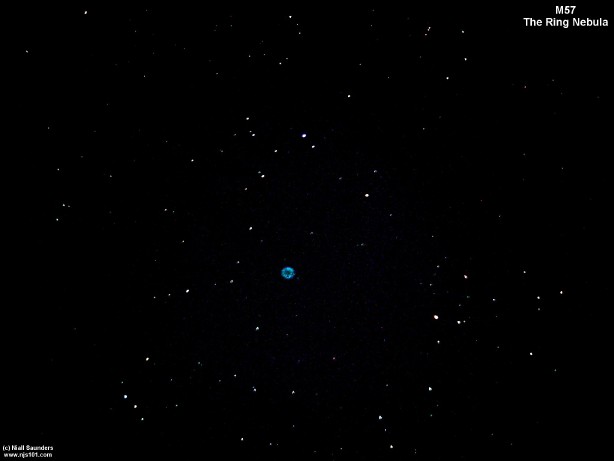
|
| Dieter.Wolf@DNSint.com (Dieter.Wolf@DNSint.com) [25 May 04] |
|
please find attached a picture of the brightest Galactic Cluster in the
northern hemisphere - M13 / NGC 6205. Unfortunately I had a little tracking
problem, so the stars are elongated - sorry about that.
With 5m.7 M13 was not visible with the naked eye here at my location, but
an easily seen 'nebulosity' in a 10x50 binocular. Sir Edmond Halley
discovered it in 1714 and - about 50 years later - Charles Messier still
thought of it as a 'nebulosity without any stars'. Today we nicely resolve
this GC into many many stars (being a total of round about 300.000, the
brightest about 12m) in an area of 150 ly. diameter. The 24,5mm SWA ocular
gives a beautiful, nearly 3-dimensional view of that 'ball of stars'.
Dieter Wolf (Munich, Germany); 2004-05-24; MEADE LXD55 SN-10 with PHILIPS ToUCam SC1 at prime focus; 90 out of 150 x 10s exposures |
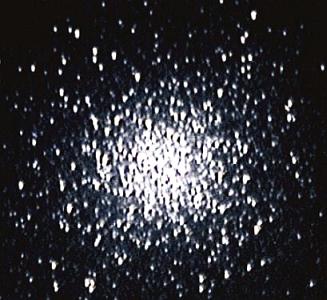
|
| Dieter.Wolf@DNSint.com [30 Apr 04] |
|
As I continue to get aquainted to my new LXD55 SN-10 - here my next deep
sky results.
Dieter Wolf (Munich, Germany); MEADE LXD55 SN-10 with PHILIPS ToUCam SC1 at prime focus; moonlit sky with 4m.5 limiting magnitude M81 (NGC3031) - "Bode's Nebula" - a great (21' x 10') and bright (7m.9) spiral galaxy in Ursa Major, the main one of the M81 group of galaxies at about 11 million ly. distance; the photo only shows the inner regions as I was not able to resolve any arms with 20x15s exposure time |
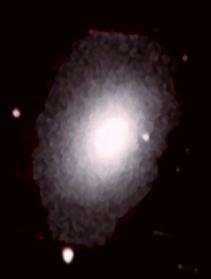
|
| M82 (NGC3034) - "Cigar Galaxy" - one of the most interesting, irregular galaxies of the northern sky with 8m.8 and 9' x 4' size; this galaxy shows bright spots and dark lanes - places of intense star birth - initiated by gravitational effects of M81; 50 out of 100 20s exposures; though being a bit weaker than M81 it's the 'eyecatcher' when viewing both galaxies together in the FOV of a 24,5 mm SWA ocular |
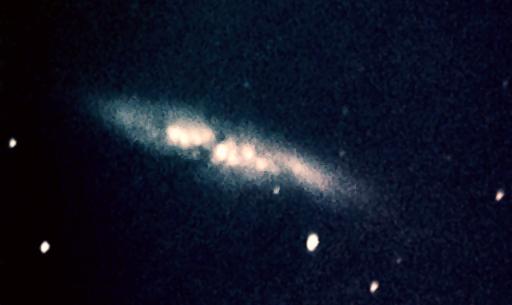
|
| Dieter.Wolf@DNSint.com [22 Apr 04] |
|
it is time for me to present my first 'real' deep sky with the LXD. Last
week during a clear, transparent night - living in the outer parts of a
million people city 'clear and transparent' means limiting magnitude about
4m.0 ... 4m.5 - I chased for M51 and M3.
Dieter Wolf (Munich, Germany); LXD55 SN-10 with ToUCam SC1 at prime focus M51 showed in the 24,5mm SWA like a 'double nebula'. With 22x35s exposure time I got this image and the first time in my life that I saw not only the bulge but a galaxy's spiral arms with my own eyes/equipment! This is a feeling similar to that of first seeing Saturn's ring system. M51 (NGC5194) is a large (about 100.000 ly.) and luminous (8m.4 in 35 million ly. distance) spiral galaxy in Canes Venatici with a 10m.5 bright irregular companion (NGC5195). We are looking 'from top' on the spiral system. |
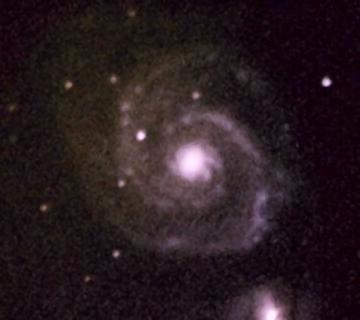
|
|
M3 could be seen in the 6x30 viewfinder. The 9x7s exposure resolves many
individual stars (the brightest of them being 12m.7) and with the 24,5mm
SWA I felt like looking at a three-dimensonal 'ball'. M3 - besides M13 - is
the richest (nearly half a million stars) and brightest (6m.2) globular
cluster of the northern hemisphere (located in Canes Venatici). It was -
by the way - the first deep sky object that Charles Messier discovered by
himself in 1764. If you look at M3 keep in mind that this cluster is about
10 billion years old - twice as old as our solar system.
I want to see a lot more of those impressive deep sky objects with my LXD (hard to imagine what could be done under a 6m.5 sky...) Thanks for your sites Mike and I hope with all the work you have providing us this place you still find time to go out and look into the starry sky... |
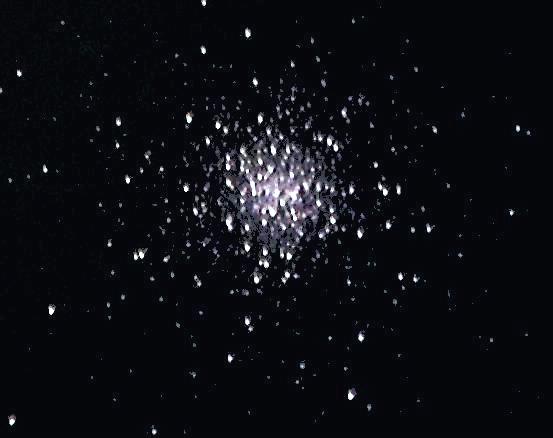
|
| Dieter.Wolf@DNSint.com [31 Mar 04] |
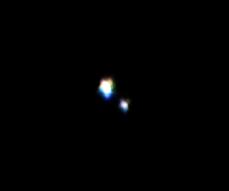 |
|
still not doing 'real' deep sky with my new SN-10. But at least this is a
star...
Dieter Wolf (Munich, Germany); 2004-03-26; MEADE LXD55 SN-10 with 3x Barlow lense; PHILIPS ToUCam SC1 at prime focus; 15 out of 400 frames Castor - Alpha Geminorum (1m.9 / 2m.9, 3".3); this not a challenge for the LXD - a lot of space between the two stars - but it was a challenge for me to find enough crisp frames to stack; this scope is MUCH more sensitive to temperature gradient airflow and / or turbulences than an ETX! Thanks for posting, Dieter |
Go to the 2003 Guest Deepsky Astrophotography Page.
Go to back to my LXD55 Home Page.